Current Progress of Ratiometric Fluorescence Sensors Based on Carbon Dots in Foodborne Contaminant Detection
Abstract
1. Introduction
2. Functionalized Modifications
2.1. Heteroatom Doping
2.2. Surface Modifications
3. Fluorescence Sensing Mechanism
3.1. SQE
3.2. FRET
3.3. IFE
3.4. AIE
4. Ratiometric Fluorescence Probes Based on CDs
4.1. CDs as Dual-Emitting Substrates
4.2. CDs as Reference Signals
| Fluorescent Probes | Analytes | Detection Mechanism | LOD | Ref. |
|---|---|---|---|---|
| QDs/CDs | Zn2+ | Ligand effect | 0.33 μM | [41] |
| QDs/CDs | CN− | Ligand effect | 10.35 nM | [42] |
| QDs/CDs | guanine | Excited state electron transfer | 3.6 μM | [43] |
| QDs/CDs | Spermine | Spermine-induced aggregation of CdTe QDs | 76 nM | [44] |
| CDs-Eu3+ | TC | Energy transfer | 11.7 nM | [46] |
| CDs-Tb | DPA | AE | 100 pM | [47] |
| CDs@Eu-MOFs | CaDPA | AE | 0.66 g/L | [48] |
| CDs/AuNCs@ZIF-8 | cephalexin | Complex formation | 0.04 ng/mL | [50] |
| BCD@SiO2@AuNC | Gram-negative bacteria | Reduction effect | 150 cfu/mL (E. coli), 112 cfu/mL (Pseudomonas aeruginosa), 792 cfu/mL (Salmonella typhimurium) | [51] |
| APTES-NBD-CDs | OA | PET | 25 ng/L | [52] |
| o-CDs@methyl red | Tyramine | pH response | 0.01 μM | [53] |
4.3. CDs as Response Signals
4.4. Dual CDs
5. The Application of Portable Devices
6. Summary and Outlook
Author Contributions
Funding
Institutional Review Board Statement
Informed Consent Statement
Data Availability Statement
Conflicts of Interest
Abbreviations
| AE | Antenna effect |
| AgNPs | Silver nanoparticles |
| AIE | Aggregation-induced luminescence |
| ALP | Alkaline phosphatase |
| Asp | Aspartic acid |
| AuNCs | Gold nanoclusters |
| BAs | Biogenic amines |
| B-CDs | Blue fluorescent CDs |
| B-CQD | Boron-doped CQD |
| CDs | Carbon dots |
| CQDs | Carbon quantum dots |
| CTC | Chlortetracycline |
| CMH | 7-diethylamino coumarin-3-carbohydrazide |
| CMP | Cytidine monophosphate |
| DA | Dopamine |
| DPA | Dipicolinic acid |
| Eu-CDs | Europium-doped CDs |
| FLQY | Fluorescence quantum yield |
| FRET | Fluorescence resonance energy transfer |
| GA-CDs | Glyoxylic-acid-modified CDs |
| GQDs | Graphene quantum dots |
| IFE | Internal filtration effect |
| LC | λ-cyfluthrin |
| L-Cys | L-cysteine |
| MNA | 6-Mercaptonicotinic acid |
| MNCs | Noble metal nanoclusters |
| MOFs | Metal-organic frameworks |
| MIP | Molecular Imprinting Polymer |
| MUA | 11-Mercaptoundecanoic acid |
| NCDs | Nitrogen-doped CDs |
| NP | Nitrobenzyl phenol |
| OPD | O-phenylenediamine |
| OPs | Organophosphorus pesticides |
| OTC | Oxytetracycline |
| RCDs | Red fluorescent CDs |
| RFS | Ratiometric fluorescence sensors |
| RhB | Rhodamine B |
| SQE | Static quenching effect |
| TC | Tetracycline |
| μPAD | Microfluidic paper-based analytical devices |
| Y-CDs | Yellow fluorescent CDs |
References
- Jia, X.; Yao, Z.; Gao, Z.; Fan, Z. The role of suspension array technology in rapid detection of foodborne pollutants: Applications and future challenges. Crit. Rev. Anal. Chem. 2021, 52, 1408–1421. [Google Scholar] [CrossRef]
- Xiong, J.; Zhang, H.; Qin, L.; Zhang, S.; Cao, J.; Jiang, H. Magnetic fluorescent quantum dots nanocomposites in food contaminants analysis: Current challenges and opportunities. Int. J. Mol. Sci. 2022, 23, 4088. [Google Scholar] [CrossRef] [PubMed]
- Shen, Y.; Wei, Y.; Zhu, C.; Cao, J.; Han, D. Ratiometric fluorescent signals-driven smartphone-based portable sensors for onsite visual detection of food contaminants. Coord. Chem. Rev. 2022, 458, 214442. [Google Scholar] [CrossRef]
- Thakur, A.; Kumar, A. Recent advances on rapid detection and remediation of environmental pollutants utilizing nanomaterials-based (bio)sensors. Sci. Total Environ. 2022, 834, 155219. [Google Scholar] [CrossRef]
- Luo, X.; Han, Y.; Chen, X.; Tang, W.; Yue, T.; Li, Z. Carbon dots derived fluorescent nanosensors as versatile tools for food quality and safety assessment: A review. Trends Food Sci. Tech. 2020, 95, 149–161. [Google Scholar] [CrossRef]
- Xu, X.; Ray, R.; Gu, Y.; Ploehn, H.; Gearheart, L.; Raker, K.; Scrivens, W. Electrophoretic analysis and purification of fluorescent single-walled carbon nanotube fragments. J. Am. Chem. Soc. 2004, 126, 12736–12737. [Google Scholar] [CrossRef] [PubMed]
- Sun, Y.; Zhou, B.; Lin, Y.; Wang, W.; Fernando, K.; Pathak, P.; Meziani, M.; Harruff, B.; Wang, X.; Wang, H.; et al. Quantum-sized carbon dots for bright and colorful photoluminescence. J. Am. Chem. Soc. 2006, 128, 7756–7757. [Google Scholar] [CrossRef]
- Chen, B.; Liu, M.; Li, C.; Huang, C. Fluorescent carbon dots functionalization. Adv. Colloid Interface Sci. 2019, 270, 165–190. [Google Scholar] [CrossRef] [PubMed]
- Sousa, H.B.A.; Martins, C.S.M.; Prior, J.A.V. You don’t learn that in school: An updated practical guide to carbon quantum dots. Nanomaterials 2021, 11, 611. [Google Scholar] [CrossRef]
- Wang, J.; Teng, X.; Wang, Y.; Si, S.; Ju, J.; Pan, W.; Wang, J.; Sun, X.; Wang, W. Carbon dots based fluorescence methods for the detections of pesticides and veterinary drugs: Response mechanism, selectivity improvement and application. TrAC-Trend Anal. Chem. 2021, 144, 116430. [Google Scholar] [CrossRef]
- Han, Y.; Yang, W.; Luo, X.; He, X.; Zhao, H.; Tang, W.; Yue, T.; Li, Z. Carbon dots based ratiometric fluorescent sensing platform for food safety. Crit. Rev. Food Sci. 2022, 62, 244–260. [Google Scholar] [CrossRef]
- Li, S.; Li, L.; Tu, H.; Zhang, H.; Silvester, D.S.; Banks, C.E.; Zou, G.; Hou, H.; Ji, X. The development of carbon dots: From the perspective of materials chemistry. Mater. Today 2021, 51, 188–207. [Google Scholar] [CrossRef]
- Chan, K.K.; Yap, S.H.K.; Yong, K.T. Biogreen synthesis of carbon dots for biotechnology and nanomedicine applications. Nanomicro Lett. 2018, 10, 268–313. [Google Scholar] [CrossRef]
- Desmond, L.J.; Phan, A.N.; Gentile, P. Critical overview on the green synthesis of carbon quantum dots and their application for cancer therapy. Environ. Sci. Nano 2021, 8, 848–862. [Google Scholar] [CrossRef]
- Kou, X.; Jiang, S.; Park, S.; Meng, L. A review: Recent advances in preparations and applications of heteroatom-doped carbon quantum dots. Dalton Trans. 2020, 49, 6915–6938. [Google Scholar] [CrossRef] [PubMed]
- Lin, L.; Luo, Y.; Tsai, P.; Wang, J.; Chen, X. Metal ions doped carbon quantum dots: Synthesis, physicochemical properties, and their applications. TrAC−Trend Anal. Chem. 2018, 103, 87–101. [Google Scholar] [CrossRef]
- Sadhanala, H.K.; Aryal, S.; Sharma, K.; Orpaz, Z.; Michaeli, S.; Gedanken, A. Nitrogen-doped carbon dots as a highly selective and sensitive fluorescent probe for sensing Mg2+ ions in aqueous solution, and their application in the detection and imaging of intracellular Mg2+ ions. Sensor Actuat. B Chem. 2022, 36, 131958. [Google Scholar] [CrossRef]
- Wu, Y.; Qin, D.; Luo, Z.; Meng, S.; Mo, G.; Jiang, X.; Deng, B. High Quantum Yield Boron and Nitrogen Codoped Carbon Quantum Dots with Red/Purple Emissions for Ratiometric Fluorescent IO4− Sensing and Cell Imaging. ACS Sustain. Chem. Eng. 2021, 16, 5195–5202. [Google Scholar] [CrossRef]
- Zhou, Q.; Fang, Y.; Li, J.; Hong, D.; Zhu, P.; Chen, S.; Tan, K. A design strategy of dual-ratiomentric optical probe based on europium-doped carbon dots for colorimetric and fluorescent visual detection of anthrax biomarker. Talanta 2021, 222, 121548. [Google Scholar] [CrossRef]
- Zhang, L.; Xing, H.; Liu, W.; Wang, Z.; Hao, Y.; Wang, H.; Dong, W.; Liu, Y.; Shuang, S.; Dong, C. 11-Mercaptoundecanoic acid-functionalized carbon dots as a ratiometric optical probe for doxorubicin detection. ACS Appl. Nano Mater. 2021, 4, 13734–13746. [Google Scholar] [CrossRef]
- Dong, H.L.; Kuzmanoski, A.; Gößl, D.M.; Popescu, R.; Gerthsen, D.; Feldmann, C. Polyol-mediated C-dot formation showing efficient Tb3+/Eu3+ emission. Chem. Commun. 2014, 50, 7503–7506. [Google Scholar] [CrossRef] [PubMed]
- Lettieri, S.; Avitabile, A.; Ventura, B.D.; Funari, R.; Ambrosio, A.; Maddalena, P.; Valadan, M.; Velotta, R.; Altucci, C. Nano- and femtosecond UV laser pulses to immobilize biomolecules onto surfaces with preferential orientation. Appl. Phys. A 2014, 117, 185–190. [Google Scholar] [CrossRef]
- Liang, S.S.; Qi, L.; Zhang, R.L.; Jin, M.; Zhang, Z.Q. Ratiometric fluorescence biosensor based on CdTe quantum and carbon dots for double strand DNA detection. Sensor Actuat. B Chem. 2014, 244, 585–590. [Google Scholar] [CrossRef]
- Zu, F.; Yan, F.; Bai, Z.; Xu, J.; Wang, Y.; Huang, Y.; Zhou, X. The quenching of the fluorescence of carbon dots: A review on mechanisms and applications. Microchim. Acta. 2017, 184, 1899–1914. [Google Scholar] [CrossRef]
- Miao, Q.; Qi, J.; Li, Y.; Fan, X.; Deng, D.; Yan, X.; He, H.; Luo, L. Anchoring zinc-doped carbon dots on a paper-based chip for highly sensitive fluorescence detection of copper ions. Analyst 2021, 146, 6297–6305. [Google Scholar] [CrossRef]
- Dong, Y.; Zhang, Y.; Zhi, S.; Yang, X.; Yao, C. Green synthesized fluorescent carbon dots from momordica charantia for selective and sensitive detection of Pd2+ and Fe3+. ChemistrySelect 2021, 6, 123–130. [Google Scholar] [CrossRef]
- Luo, J.; Li, S.; Pang, C.; Wang, M.; Ma, X.; Zhang, C. Highly selective fluorescence probe for imidacloprid measurement based on fluorescence resonance energy transfer. Microchem. J. 2022, 175, 107172. [Google Scholar] [CrossRef]
- Abdolmohammad-Zadeh, H.; Azari, Z.; Pourbasheer, E. Fluorescence resonance energy transfer between carbon quantum dots and silver nanoparticles: Application to mercuric ion sensing. Spectrochim. Acta A Mol. Biomol. Spectrosc. 2021, 245, 118924. [Google Scholar] [CrossRef]
- Park, S.J. “Turn on” fluorescence sensor of glutathione based on inner filter effect of co-doped carbon dot/gold nanoparticle composites. Int. J. Mol. Sci. 2021, 23, 190. [Google Scholar]
- An, X.; Tan, Q.; Pan, S.; Zhen, S.; Hu, Y.; Hu, X. Determination of xanthine using a ratiometric fluorescence probe based on boron-doped carbon quantum dots and gold nanoclusters. Microchim. Acta. 2022, 189, 148. [Google Scholar] [CrossRef]
- Liang, X.; Dong, B.; Wang, H.; Zhang, Z.; Wang, S.; Li, J.; Zhao, B.; Li, Z.; Xing, Y.; Guo, K. An AIE-active acridine functionalized spiro[fluorene-9,9′-xanthene] luminophore with mechanoresponsive luminescence for anti-counterfeiting, information encryption and blue OLEDs. J. Mater. Chem. C 2022, 10, 7857–7865. [Google Scholar] [CrossRef]
- Liu, X.; Zhu, C.; Tang, B. Bringing inherent charges into aggregation-induced emission research. Acc. Chem. Res. 2022, 55, 197–208. [Google Scholar] [CrossRef] [PubMed]
- Li, R.; Hou, X.; Yuan, M.; Long, Y.; Chen, S. Carbon dots synthesized and its applications in the detection of chlortetracycline and water based on the aggregation-induced emission. ChemistrySelect 2020, 5, 649–654. [Google Scholar] [CrossRef]
- Lv, W.; Lin, M.; Li, R.; Zhang, Q.; Liu, H.; Wang, J.; Huang, C. Aggregation-induced emission enhancement of yellow photoluminescent carbon dots for highly selective detection of environmental and intracellular copper (II) ions. Chinese Chem. Lett. 2019, 30, 1410–1414. [Google Scholar] [CrossRef]
- Bigdeli, A.; Ghasemi, F.; Abbasi-Moayed, S.; Shahrajabian, M.; Fahimi-Kashani, N.; Jafarinejad, S.; Farahmand-Nejad, M.A.; Hormozi-Nezhad, M.R. Ratiometric fluorescent nanoprobes for visual detection: Design principles and recent advances—A review. Anal. Chim. Acta 2019, 1079, 30–58. [Google Scholar] [CrossRef] [PubMed]
- Liu, J.; Li, Y.; Liu, L.; Gao, Y.; Zhang, Y.; Yin, Z.; Pi, F.; Sun, X. Current progress on antibiotic sensing based on ratiometric fluorescent sensors. Bull. Environ. Contam. Toxicol. 2021, 107, 176–184. [Google Scholar] [CrossRef]
- Yan, F.; Bai, Z.; Liu, F.; Zu, F.; Zhang, R.; Xu, J.; Chen, L. Ratiometric fluorescence probes based on carbon dots. Curr. Org. Chem. 2018, 22, 57–66. [Google Scholar] [CrossRef]
- Karami, S.; Shamsipur, M.; Barati, A. Intrinsic dual-emissive carbon dots for efficient ratiometric detection of Cu2+ and aspartic acid. Anal. Chim. Acta 2021, 1144, 26–33. [Google Scholar] [CrossRef]
- Lv, Y.; Li, P.; Liu, C.; Xia, L.; Qu, F.; Kong, R.; Song, Z. Long-wavelength emission carbon dots as self-ratiometric fluorescent nanoprobe for sensitive determination of Zn2+. Microchim. Acta 2022, 189, 55. [Google Scholar] [CrossRef]
- Liu, J.; Chen, Y.; Wang, L.; Na, M.; Chen, H.; Chen, X. Modification-free fabricating ratiometric nanoprobe based on dual-emissive carbon dots for nitrite determination in food samples. J. Agric. Food. Chem. 2019, 67, 3826–3836. [Google Scholar] [CrossRef]
- Song, Q.; Ma, Y.; Wang, X.; Tang, T.; Song, Y.; Ma, Y.; Xu, G.; Wei, F.; Cen, Y.; Hu, Q. “On-off-on” fluorescent system for detection of Zn2+ in biological samples using quantum dots-carbon dots ratiometric nanosensor. J. Colloid Interf. Sci. 2018, 516, 522–528. [Google Scholar] [CrossRef]
- Wang, J.; Li, D.; Qiu, Y.; Liu, X.; Hu, J. Synergistic effect of fluorescence recovery and enhancement on ultrasensitive visual assay of cyanide anions based on N-acetyl-L-cysteine-capped CdTe quantum dots and carbon dots. Sensor Actuat. B Chem. 2019, 301, 126984. [Google Scholar] [CrossRef]
- Xu, X.; He, L.; Long, Y.; Pan, S.; Liu, H.; Yang, J.; Hu, X. S-doped carbon dots capped ZnCdTe quantum dots for ratiometric fluorescence sensing of guanine. Sensor Actuat. B Chem. 2019, 279, 44–52. [Google Scholar] [CrossRef]
- Fu, Y.; Wu, S.; Zhou, H.; Zhao, S.; Song, X. Carbon dots and a CdTe quantum dot hybrid-based fluorometric probe for spermine detection. Ind. Eng. Chem. Res. 2020, 59, 1723–1729. [Google Scholar] [CrossRef]
- Liu, C.; Lu, D.; You, X.; Shi, G.; Deng, J.; Zhou, T. Carbon dots sensitized lanthanide infinite coordination polymer nanoparticles: Towards ratiometric fluorescent sensing of cerebrospinal Aβ monomer as a biomarker for Alzheimer’s disease. Anal. Chim. Acta 2020, 1105, 147–154. [Google Scholar] [CrossRef] [PubMed]
- Shen, Z.; Zhang, C.; Yu, X.; Li, J.; Wang, Z.; Zhang, Z.; Liu, B. Microwave-assisted synthesis of cyclen functional carbon dots to construct a ratiometric fluorescent probe for tetracycline detection. J. Mater. Chem. C 2018, 6, 9636–9641. [Google Scholar] [CrossRef]
- Liu, M.; Chen, B.; He, J.; Li, C.; Li, Y.; Huang, C. Anthrax biomarker: An ultrasensitive fluorescent ratiometry of dipicolinic acid by using terbium (III)-modified carbon dots. Talanta 2019, 191, 443–448. [Google Scholar] [CrossRef]
- Yi, K.; Zhang, X.; Zhang, L. Eu3+@metal–organic frameworks encapsulating carbon dots as ratiometric fluorescent probes for rapid recognition of anthrax spore biomarker. Sci. Total Environ. 2020, 743, 140692. [Google Scholar] [CrossRef] [PubMed]
- Chen, L.; Cheng, Z.; Luo, M.; Wang, T.; Zhang, L.; Wei, J.; Wang, Y.; Li, P. Fluorescent noble metal nanoclusters for contaminants analysis in food matrix. Crit. Rev. Food Sci. 2021. [Google Scholar] [CrossRef]
- Jalili, R.; Irani-Nezhad, M.H.; Khataee, A.; Joo, S.W. A ratiometric fluorescent probe based on carbon dots and gold nanocluster encapsulated metal-organic framework for detection of cephalexin residues in milk. Spectrochim. Acta A Mol. Biomol. Spectrosc. 2021, 18, 120089. [Google Scholar] [CrossRef]
- Fu, L.; Chen, Q.; Jia, L. Carbon dots and gold nanoclusters assisted construction of a ratiometric fluorescent biosensor for detection of Gram-negative bacteria. Food Chem. 2022, 374, 131750. [Google Scholar] [CrossRef] [PubMed]
- Lian, Z.; Zhao, M.; Wang, J.; Yu, R. Dual-emission ratiometric fluorescent sensor based molecularly imprinted nanoparticles for visual detection of okadaic acid in seawater and sediment. Sensor Actuat. B Chem. 2021, 346, 130465. [Google Scholar] [CrossRef]
- Meng, G.; Zhang, C.; Du, P.; Sun, S.; Zhang, X.; Wang, B.; Lu, X. A dual-channel luminescent signal readout nanoprobe for rapid monitoring of biogenic amines in milk and yogurt. Sensor Actuat. B Chem. 2022, 357, 131435. [Google Scholar] [CrossRef]
- Chu, S.; Wang, H.; Ling, X.; Yu, S.; Yang, L.; Jiang, C. A portable smartphone platform using a ratiometric fluorescent paper strip for visual quantitative sensing. ACS Appl. Mater. Interfaces 2020, 12, 12962–12971. [Google Scholar] [CrossRef]
- Xu, H.; Zhang, K.; Liu, Q.; Liu, Y.; Xie, M. Visual and fluorescent detection of mercury ions by using a dually emissive ratiometric nanohybrid containing carbon dots and CdTe quantum dots. Microchim. Acta 2017, 184, 1199–1206. [Google Scholar] [CrossRef]
- He, W.; Gui, R.; Jin, H.; Wang, B.; Bu, X.; Fu, Y. Ratiometric fluorescence and visual imaging detection of dopamine based on carbon dots/copper nanoclusters dual-emitting nanohybrids. Talanta 2018, 178, 109–115. [Google Scholar] [CrossRef] [PubMed]
- Yang, Y.; Xing, X.; Zou, T.; Wang, Z.; Zhao, R.; Hong, P.; Peng, S.; Zhang, X.; Wang, Y. A novel and sensitive ratiometric fluorescence assay for carbendazim based on N-doped carbon quantum dots and gold nanocluster nanohybrid. J. Hazard Mater. 2020, 386, 121958. [Google Scholar] [CrossRef]
- Wang, C.; Tan, R.; Chen, D. Fluorescence method for quickly detecting ochratoxin A in flour and beer using nitrogen doped carbon dots and silver nanoparticles. Talanta 2018, 182, 363–370. [Google Scholar] [CrossRef]
- Guo, Z.; Zhu, Z.; Sun, Z.; Zhang, X.; Chen, Y. Synthesis of dual-emitting (Gd,Eu)2O3-PEI@CD composite and its potential as ratiometric fluorescent sensor for curcumin. Mater. Res. Bull. 2018, 108, 83–88. [Google Scholar] [CrossRef]
- He, X.; Han, Y.; Luo, X.; Yang, W.; Li, C.; Tang, W.; Yue, T.; Li, Z. Terbium (III)-referenced N-doped carbon dots for ratiometric fluorescent sensing of mercury (II) in seafood. Food Chem. 2020, 320, 126624. [Google Scholar] [CrossRef]
- Hu, J.; Yang, X.; Peng, Q.; Wang, F.; Zhu, Y.; Hu, X.; Zheng, B.; Du, J.; Xiao, D. A highly sensitive visual sensor for tetracycline in food samples by a double-signal response fluorescent nanohybrid. Food Control 2020, 108, 106832. [Google Scholar] [CrossRef]
- Hu, X.; Guo, Y.; Zhang, J.; Wang, X.; Fang, G.; Wang, S. A signal-amplified ratiometric fluorescence biomimetic sensor based on the synergistic effect of IFE and AIE for the visual smart monitoring of oxytetracycline. Chem. Eng. J. 2022, 433, 134499. [Google Scholar] [CrossRef]
- Tao, H.; Zhang, Z.; Cao, Q.; Li, L.; Xu, S.; Jiang, C.; Li, Y.; Liu, Y. Ratiometric fluorescent sensors for nitrite detection in the environment based on carbon dot/Rhodamine B systems. RSC Adv. 2022, 12, 12655–12662. [Google Scholar] [CrossRef] [PubMed]
- Lu, C.; Liu, G.; Yang, Z.; Wang, Y.; Rao, H.; Zhang, W.; Jing, B.; Wang, X. A ratiometric fluorometric ciprofloxacin assay based on the use of riboflavin and carbon dots. Microchim. Acta 2020, 187, 37. [Google Scholar] [CrossRef] [PubMed]
- Yan, F.; Bai, Z.; Chen, Y.; Zu, F.; Li, X.; Xu, J.; Chen, L. Ratiometric fluorescent detection of copper ions using coumarin-functionalized carbon dots based on FRET. Sensor Actuat. B Chem. 2018, 275, 86–94. [Google Scholar] [CrossRef]
- Li, H.; Su, D.; Gao, H.; Yan, X.; Kong, D.; Jin, R.; Liu, X.; Wang, C.; Lu, G. Design of red emissive carbon dots: Robust performance for analytical applications in pesticide monitoring. Anal. Chem. 2020, 92, 3198–3205. [Google Scholar] [CrossRef]
- Xing, X.; Huang, L.; Zhao, S.; Xiao, J.; Lan, M. S, N-doped carbon dots for tetracyclines sensing with a fluorometric spectral response. Microchem. J. 2020, 157, 105065. [Google Scholar] [CrossRef]
- Zhu, X.; Jiang, W.; Zhao, Y.; Liu, H.; Sun, B. Single, dual and multi-emission carbon dots based optosensing for food safety. Trends Food Sci. Tech. 2021, 111, 388–404. [Google Scholar] [CrossRef]
- Shao, K.; Yang, Y.; Ye, S.; Gu, D.; Wang, T.; Teng, Y.; Shen, Z.; Pan, Z. Dual-colored carbon dots-based ratiometric fluorescent sensor for high-precision detection of alkaline phosphatase activity. Talanta 2020, 208, 120460. [Google Scholar] [CrossRef]
- Lu, H.; Xu, S.; Liu, J. One pot generation of blue and red carbon dots in one binary solvent system for dual channel detection of Cr3+ and Pb2+ based on ion imprinted fluorescence polymers. ACS Sens. 2019, 8, 1917–1924. [Google Scholar] [CrossRef]
- Zhu, X.; Han, L.; Liu, H.; Sun, B. A smartphone-based ratiometric fluorescent sensing system for on-site detection of pyrethroids by using blue-green dual-emission carbon dots. Food Chem. 2022, 379, 132154. [Google Scholar] [CrossRef] [PubMed]
- Deng, H.; Wu, Z.; Zhao, Z.; Zhu, L.; Tang, M.; Yu, R.; Wang, J. Dual-channel fluorescent signal readout strategy for cysteine sensing. Talanta 2021, 231, 122331. [Google Scholar] [CrossRef] [PubMed]
- Qi, J.; Fan, X.; Deng, D.; He, H.; Luo, L. Progress in Rapid Detection Techniques Using Paper-based Platforms for Food Safety. Chinese J. Anal. Chem. 2020, 48, 1616–1624. [Google Scholar] [CrossRef]
- Guo, X.; Liu, C.; Li, N.; Zhang, S.; Wang, Z. Ratiometric fluorescent test paper based on silicon nanocrystals and carbon dots for sensitive determination of mercuric ions. R. Soc. Open Sci. 2018, 5, 171922. [Google Scholar] [CrossRef] [PubMed]
- You, J.; Ji, J.; Wu, J.; Wang, S.; Chen, P.; Mao, R.; Jin, Y.; Zhang, L.; Du, S. Ratiometric fluorescent test pen filled with a mixing ink of carbon dots and CdTe quantum dots for portable assay of silver ion on paper. Microchim. Acta 2020, 187, 391. [Google Scholar] [CrossRef]
- Zhu, L.; Mei, X.; Peng, Z.; Yang, J.; Li, Y. A paper-based microfluidic sensor array combining molecular imprinting technology and carbon quantum dots for the discrimination of nitrophenol isomers. J. Hazard Mater. 2022, 435, 129012. [Google Scholar] [CrossRef]
- Pandit, S.; Banerjee, T.; Srivastava, I.; Nie, S.; Pan, D. Machine learning-assisted array-based biomolecular sensing using surface-functionalized carbon dots. ACS Sens. 2019, 4, 2730–2737. [Google Scholar] [CrossRef] [PubMed]
- Xu, Z.; Chen, J.; Liu, Y.; Wang, X.; Shi, Q. Multi-emission fluorescent sensor array based on carbon dots and lanthanide for detection of heavy metal ions under stepwise prediction strategy. Chem. Eng. J. 2022, 441, 135690. [Google Scholar] [CrossRef]
- Huang, S.; Yao, J.; Li, B.; Ning, G.; Xiao, Q. Integrating target-responsive CD-CdTe QD-based ratiometric fluorescence hydrogel with smartphone for visual and on-site determination of dichlorvos. Microchim. Acta 2021, 188, 318. [Google Scholar] [CrossRef]
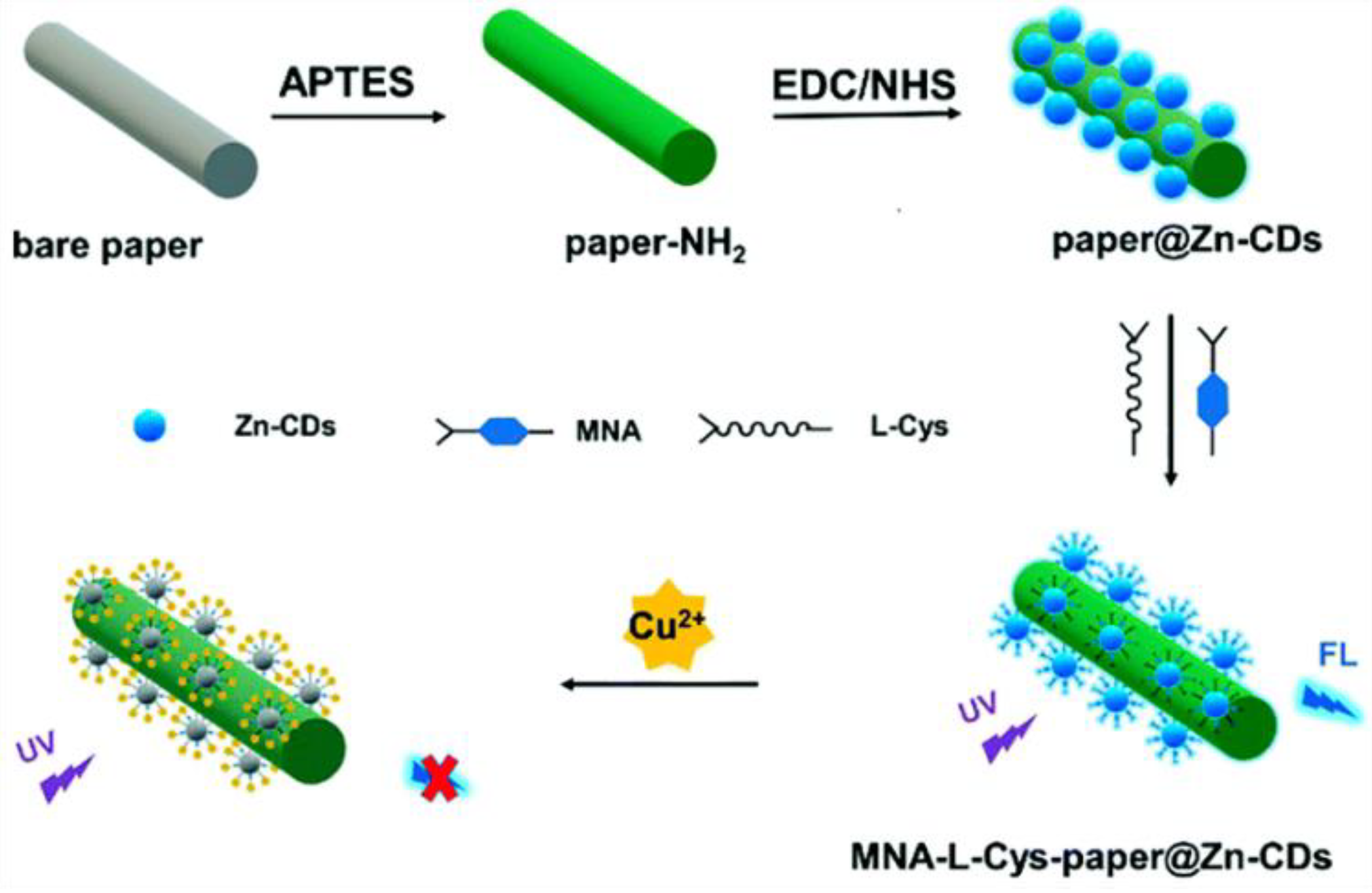

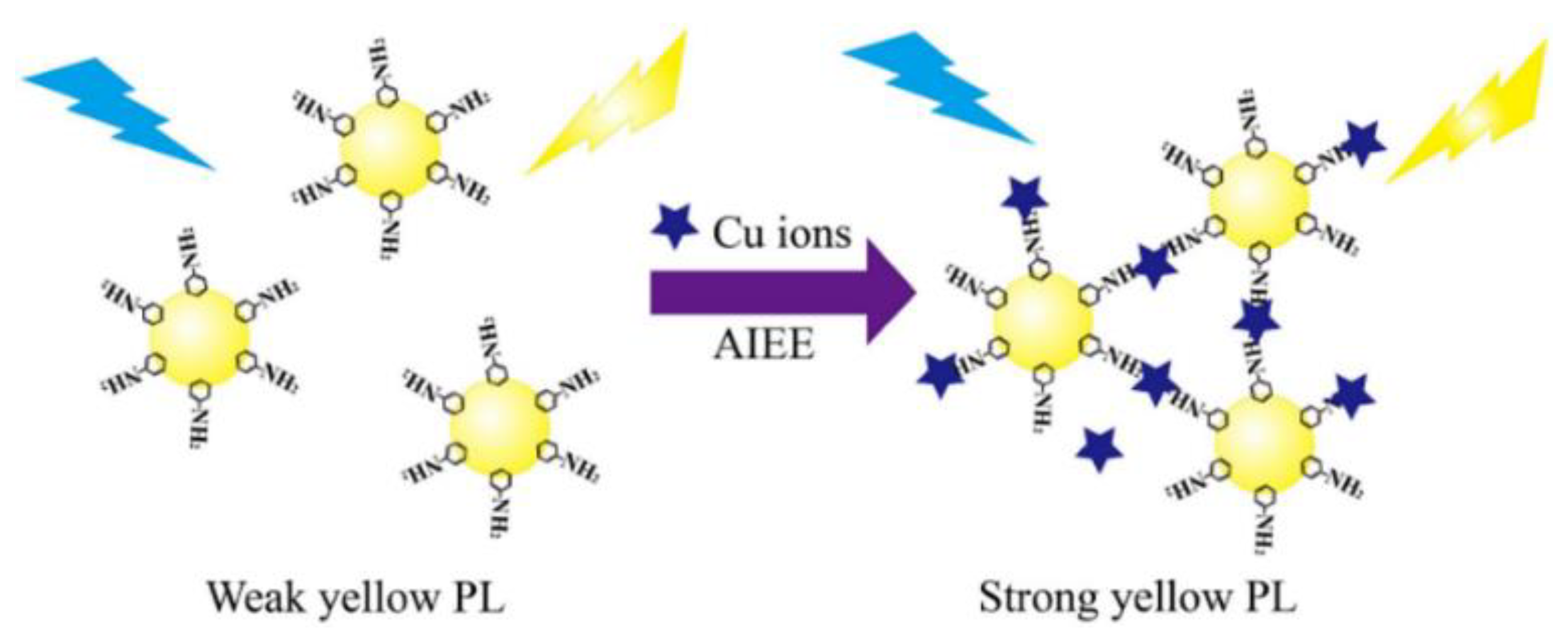
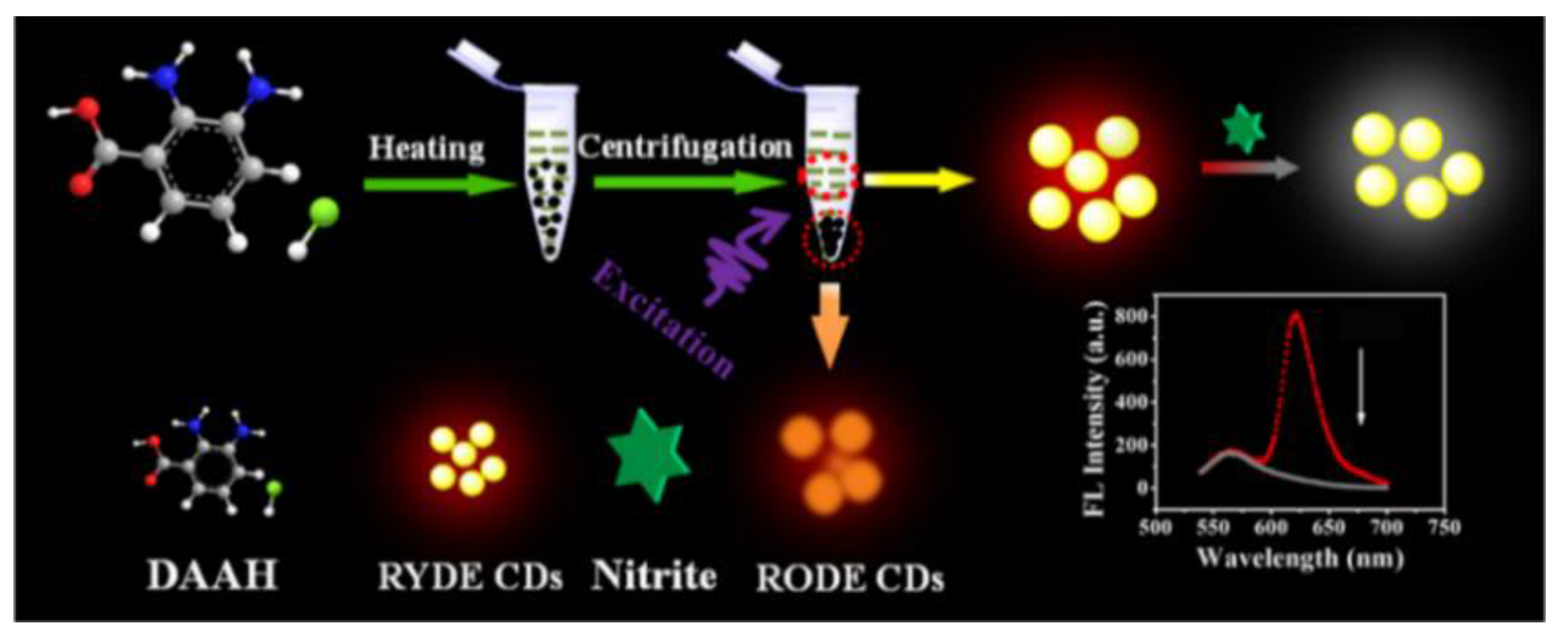


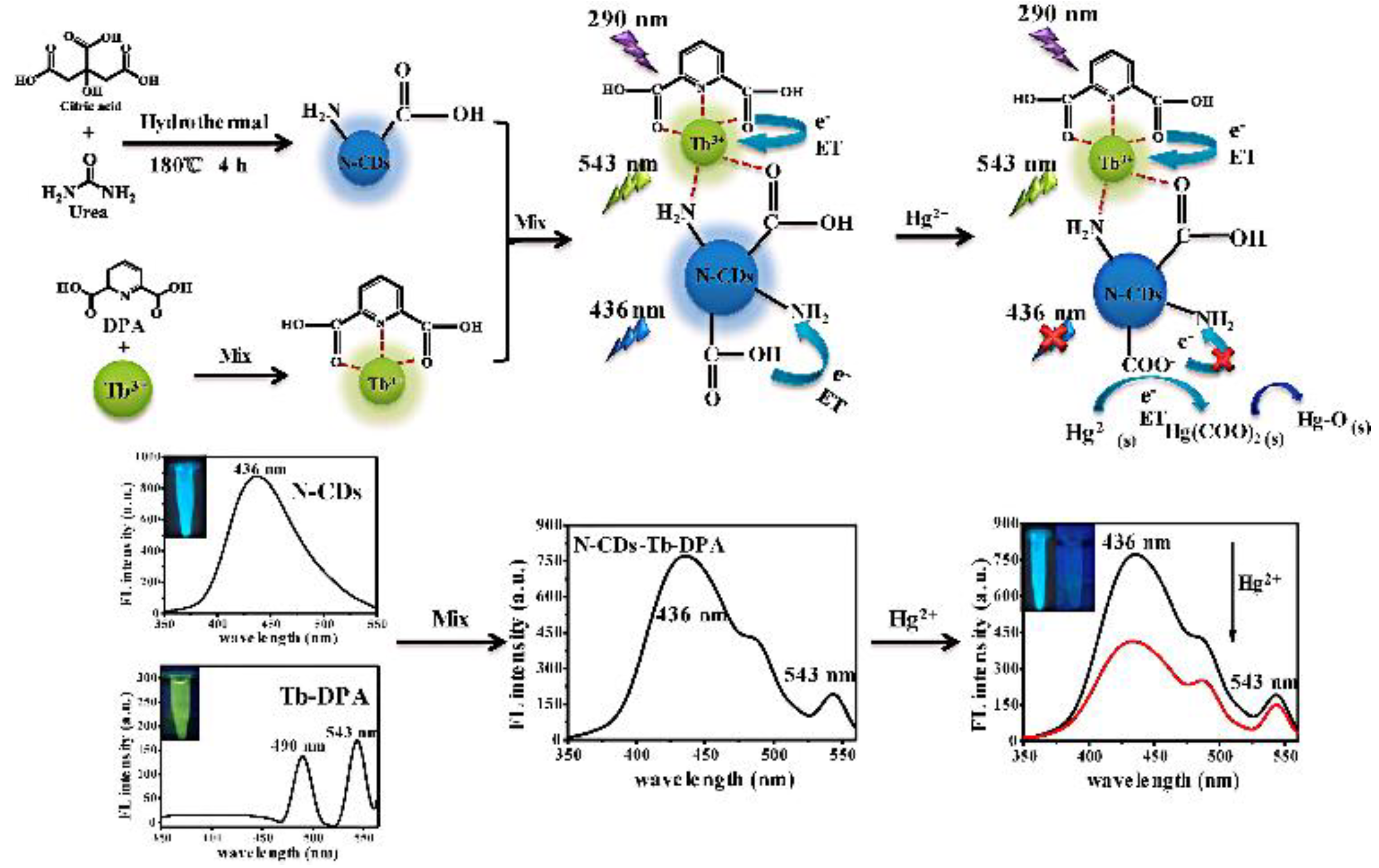


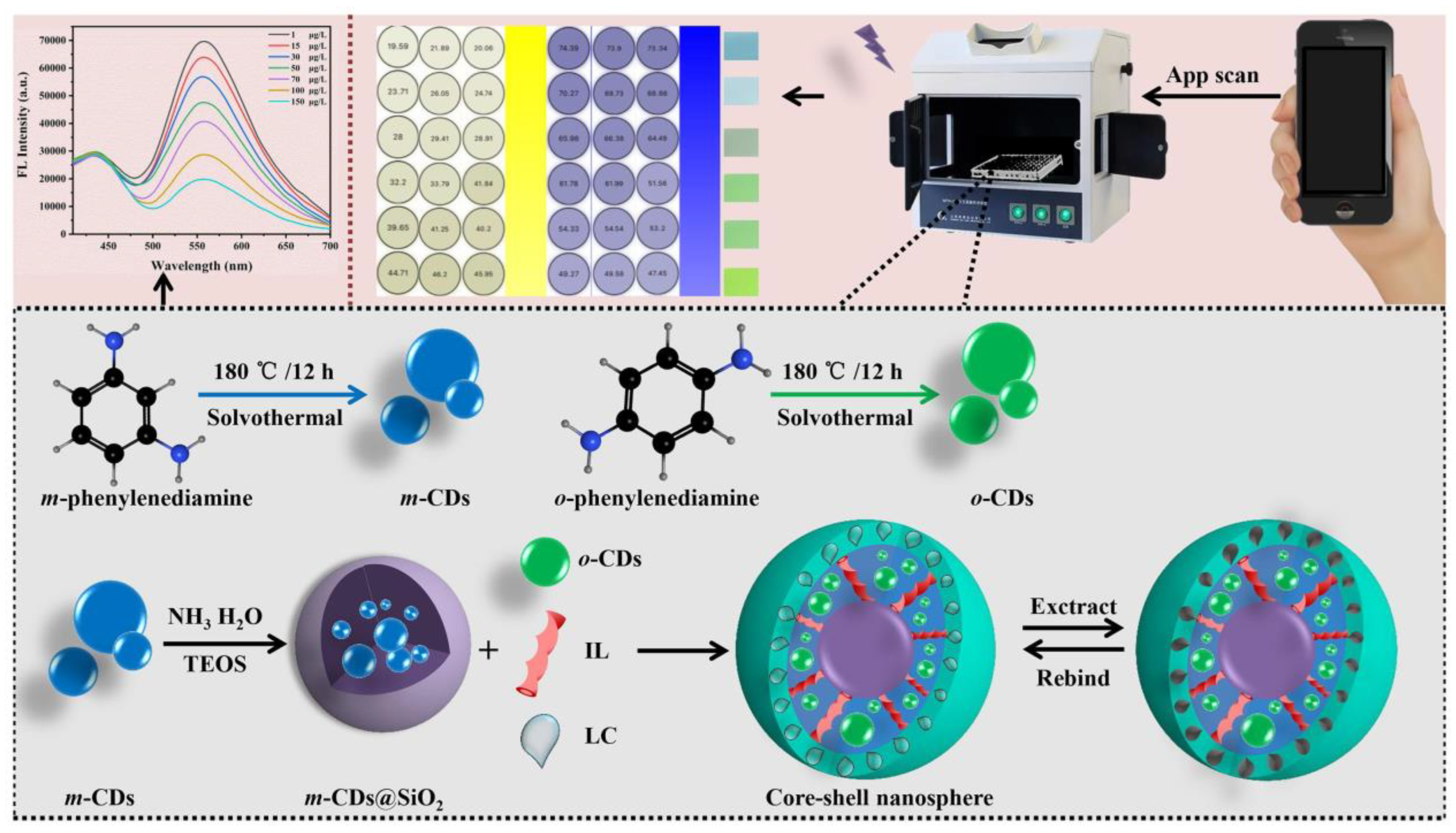
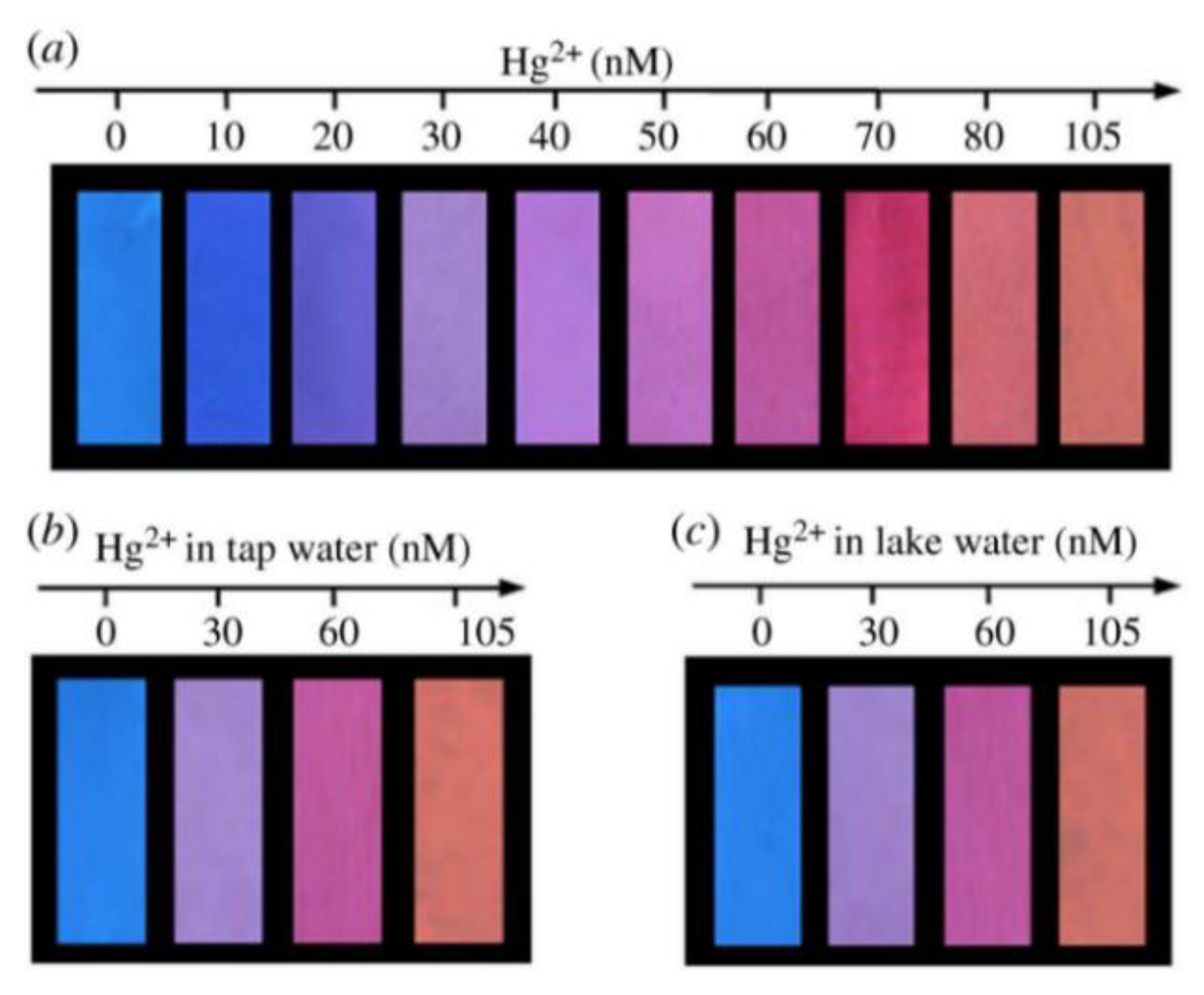

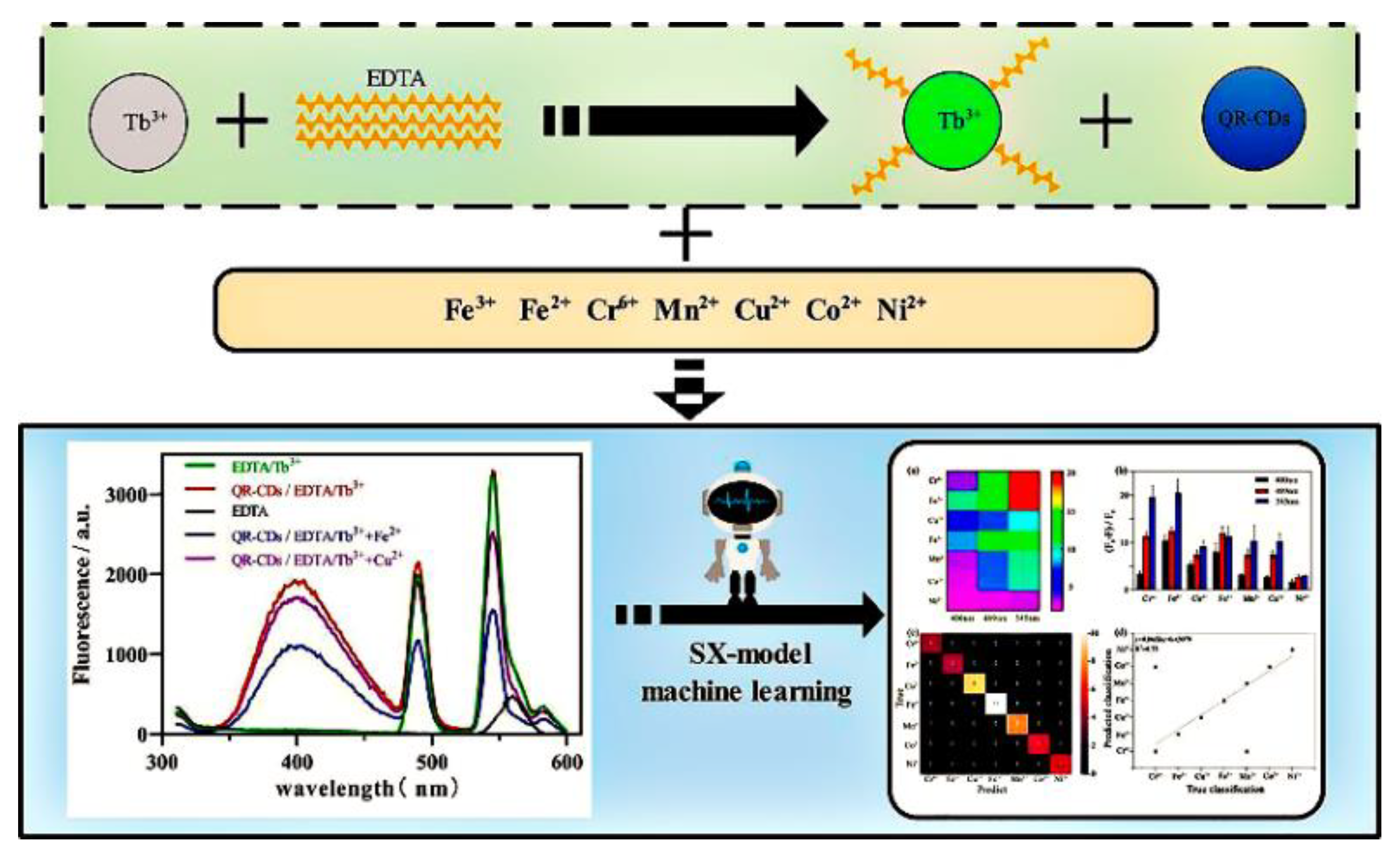
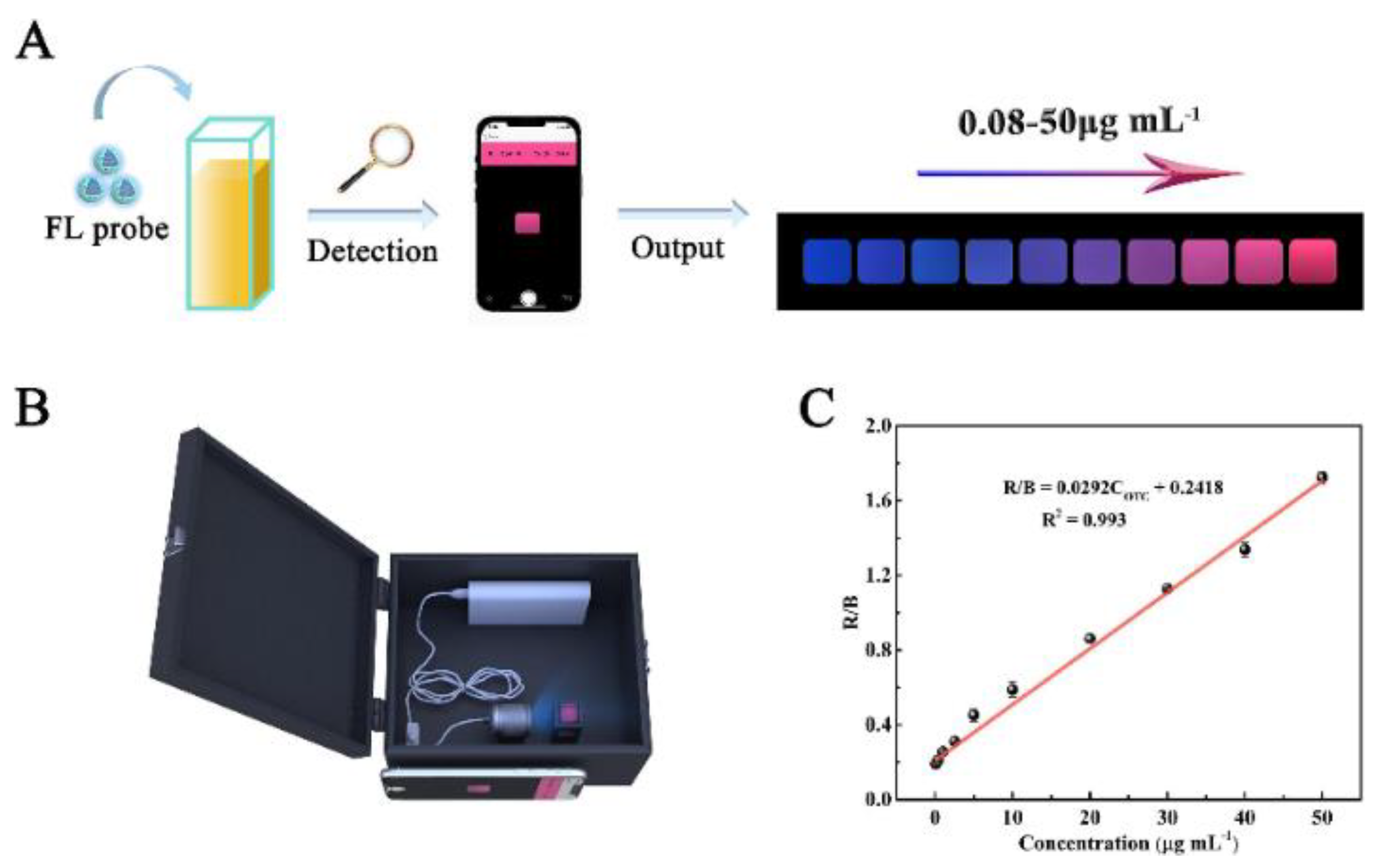
| Fluorescent Probes | Analytes | Detection Mechanism | LOD | Ref. |
|---|---|---|---|---|
| rQDs@SiO2@CDs | Fomesin | Fomesin induced AuNPs aggregation | 59 nM | [54] |
| QDs@SiO2@CDs | Hg2+ | SQE | 0.47 nM | [55] |
| CDs/CuNCs | DA | Electronic transfer | 32 nM | [56] |
| N-CQDs/AuNCs | Polymyxin | FRET | 0.83 μM | [57] |
| CDs/AgNCs | ochratoxin A | FRET | 8.7 nM | [58] |
| (Gd,Eu)2O3-PEI@CD | Curcumin | IFE | 0.0615 μg/mL | [59] |
| N-CDs-Tb-DPA | Hg2+ | Electronic transfer | 37 nM | [60] |
| Eu/CMP-cit CPNs | TC | IFE/AE | 8 nM | [61] |
| Mg,N-CDs/Eu-MOFs@MIP | Tonomycin | IFE/AE | 6.6 ng/mL | [62] |
| CDs-RhB | nitrite | Griess-like mechanism | 67 nM | [63] |
| CDs/riboflavin | CIP | Hydrogen bonding/Conjugation effect | 0.13 μM | [64] |
| CMH-GA-CDs | Cu2+ | FRET | 0.21 μM | [65] |
| CDs/DA | OPs | PET | 0.025 pg/mL | [66] |
| S,N-CDs/TC | TC | IFE | 0.25 μM | [67] |
Disclaimer/Publisher’s Note: The statements, opinions and data contained in all publications are solely those of the individual author(s) and contributor(s) and not of MDPI and/or the editor(s). MDPI and/or the editor(s) disclaim responsibility for any injury to people or property resulting from any ideas, methods, instructions or products referred to in the content. |
© 2023 by the authors. Licensee MDPI, Basel, Switzerland. This article is an open access article distributed under the terms and conditions of the Creative Commons Attribution (CC BY) license (https://creativecommons.org/licenses/by/4.0/).
Share and Cite
Zhang, J.; Chen, H.; Xu, K.; Deng, D.; Zhang, Q.; Luo, L. Current Progress of Ratiometric Fluorescence Sensors Based on Carbon Dots in Foodborne Contaminant Detection. Biosensors 2023, 13, 233. https://doi.org/10.3390/bios13020233
Zhang J, Chen H, Xu K, Deng D, Zhang Q, Luo L. Current Progress of Ratiometric Fluorescence Sensors Based on Carbon Dots in Foodborne Contaminant Detection. Biosensors. 2023; 13(2):233. https://doi.org/10.3390/bios13020233
Chicago/Turabian StyleZhang, Jialu, Huinan Chen, Kaidi Xu, Dongmei Deng, Qixian Zhang, and Liqiang Luo. 2023. "Current Progress of Ratiometric Fluorescence Sensors Based on Carbon Dots in Foodborne Contaminant Detection" Biosensors 13, no. 2: 233. https://doi.org/10.3390/bios13020233
APA StyleZhang, J., Chen, H., Xu, K., Deng, D., Zhang, Q., & Luo, L. (2023). Current Progress of Ratiometric Fluorescence Sensors Based on Carbon Dots in Foodborne Contaminant Detection. Biosensors, 13(2), 233. https://doi.org/10.3390/bios13020233






